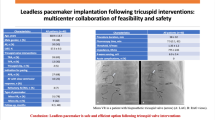Abstract
Background
Prior studies report permanent pacemaker (PPM)-induced tricuspid regurgitation (TR) in up to one third of cases late post-implantation. We sought to assess the extent of immediate PPM-induced TR.
Methods
Forty patients undergoing PPM implant were prospectively enrolled. Patients with pre-existing moderate or severe TR or an RVSP >50 mmHg were excluded. Pre- and immediate post-implantation transthoracic echocardiography (TTE) analyzed TR grade according to established methods. 3D TTE was utilized to determine lead position in relation to tricuspid leaflets as well as lead mobility across the TV.
Results
Of 40 patients, four were excluded due to baseline moderate TR (n = 3) or RVSP >50 mmHg (n = 1). In the remaining cohort (n = 36), immediate post-implantation TTE showed no increase in TR grade in 30 patients (83%), whereas a one-grade increase from no/trace to mild occurred in six (17%) others. In no patient did immediate moderate or severe TR develop. Exclusive RV pacing was present in 47% of the patients; however, only two of the six patients with increased TR were paced. 3D TTE identified lead position in 92% of the cases—more than 50% of the cases showed RV lead distribution in the middle or post eroseptal commissure of the TV. Lead immobility was seen in only three of the six patients with increased TR.
Conclusions
These findings show that significant PPM-induced TR is uncommon immediately post-implantation and, when it occurs, causes no greater than mild TR. RV pacing and lead mobility do not correlate with worsening of TR. 3D TTE is highly reliable at identifying lead position.





Similar content being viewed by others
References
Al-Mohaissen MA, Chan KL. Prevalence and mechanism of tricuspid regurgitation following implantation of endocardial leads for pacemaker or cardioverter-defibrillator. J Am Soc Echocardiogr. 2012;25:245–52.
Hoke U, Auger D, Thijssen J, et al. Significant lead-induced tricuspid regurgitation is associated with poor prognosis at long-term follow up. Heart. 2014;100:960–8.
Nath J, Foster E, Heidenreich PA. Impact of tricuspid regurgitation on long-term survival. J Am Coll Cardiol. 2004;43(3):405–9.
Lin G, Nishimura R, Connolly H. Severe symptomatic tricuspid valve regurgitation due to permanent pacemaker or implantable cardioverter-defibrillator leads. J Am Coll Cardiol 2005;45.10.
Gould L, Reddy CV, Yacob U. Perforation of the tricuspid valve by a transvenous pacemaker. J Am Med Assoc. 1974;230(1):86–7.
Chang J, Manning W, Ebrille E, Zimetbaum P. Tricuspid valve dysfunction following pacemaker or cardioverter-defibrillator implantation. J Am Coll Cardiol. 2017;69(18):2331–41.
De Cock CC, Vinkers M, Van Campe LC. Long-term outcome of patients with multiple, non-infected transvenous leads: a clinical and echocardiographic study. Pacing Clin Electrophysiol. 2000;23:423–6.
Klutstein M, Balkin J, Butnaru A, et al. Tricuspid incompetence following permanent pacemaker implantation. Pacing Clin Electrophysiol. 2009;32:135–7.
Webster G, Margossian R, Alexander ME, et al. Impact of transvenous ventricular pacing leads on tricuspid regurgitation in pediatric and congenital heart disease patients. J Interv Card Electrophysiol. 2008;21:65–8.
Kim JB, Spevack DM, Tunick PA, et al. The effect of transvenous pacemaker and implantable cardioverter defibrillator lead placement on tricuspid valve function: an observational study. J Am Soc Echocardiogr. 2008;21:284–7.
Kucukarslan N, Kirilmaz A, Ulusoy E, et al. Tricuspid insufficiency does not increase early after permanent implantation of pacemaker leads. J Card Surg. 2006;21:391–4.
Leibowitz D, Rosenheck S, Pollak A. Transvenous pacemaker leads do not worsen tricuspid regurgitation: a prospective echocardiographic study. Cardiology. 2000;93:74–7.
Zoghbi W, Adams D, Bonow R, et al. Recommendations for noninvasive evaluation of native valvular regurgitation. J Am Soc Echocardiogr. 2017:1–69.
Mediratta A, Addetia K, Yamat M, et al. 3D echocardiographic location of implantable device leads and mechanism of associated tricuspid regurgitation. J Am Coll Cardiol Img. 2014;7(4):337–47.
Al-Bawardy R, Krishnaswamy A, Bhargava M, et al. Tricuspid regurgitation in patients with pacemakers and implantable cardiac defibrillators: a comprehensive review. Clin Cardiol. 2013;36(5):249–54.
Williams John CP, O'Donovan Paul B, Vandenberg RA. Atriogenic mitral valve reflux: diastolic incompetence following isolated atrial systoles. Circ Res. 1968;22:19–27.
Vaturi M, Kusniec J, Shapira Y, et al. Right ventricular pacing increases tricuspid regurgitation grade regardless of mechanical interference to the valve by the electrode. Eur J Echocardiogr. 2010;11:550–3.
Acknowledgements
The authors thank the following sonographers who acquired images for the study: Nada Popa, Nevien Hanna, Besjana Mani, Sandra Senkowski, Patricia Bailey, and John Alban.
Author information
Authors and Affiliations
Contributions
Drs Rothschild, Goldstein, Kerner, Abbas, and Wong: study concept, design, data analysis, and interpretation. Drs Rothschild, Goldstein, Kerner Abbas, and Wong: drafting article, critical revision. Drs Rothschild and Patel: data collection. All authors reviewed and approved the final manuscript.
Corresponding author
Ethics declarations
Conflict of interest
The authors declare that they have no conflicts of interest.
Funding
Non-applicable
Ethical approval
The Beaumont Research Institute IRB approved the study protocol 1/22/16 and also conducted a First Subject Monitoring review 3/10/16. All procedures performed in studies involving human participants were in accordance with the ethical standards of the institutional and/or national research committee and with the 1964 Helsinki declaration and its later amendments or comparable ethical standards.
Informed consent
Informed consent was obtained from all individual participants included in the study.
Rights and permissions
About this article
Cite this article
Rothschild, D.P., Goldstein, J.A., Kerner, N. et al. Pacemaker-induced tricuspid regurgitation is uncommon immediately post-implantation. J Interv Card Electrophysiol 49, 281–287 (2017). https://doi.org/10.1007/s10840-017-0266-2
Received:
Accepted:
Published:
Issue Date:
DOI: https://doi.org/10.1007/s10840-017-0266-2




